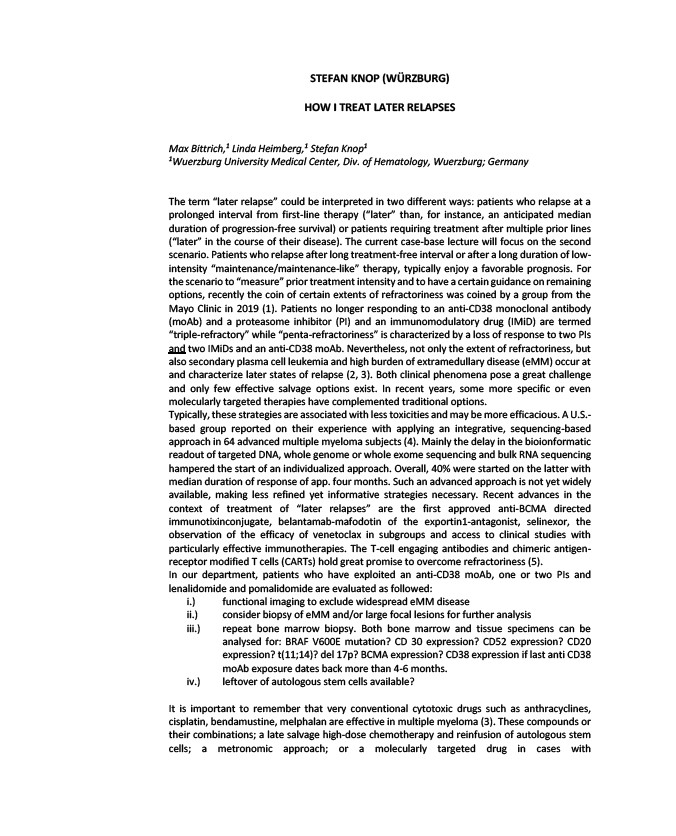
STEFAN KNOP (WÜRZBURG)
HOW I TREAT LATER RELAPSES
Max Bittrich,1 Linda Heimberg,1 Stefan Knop1
1Wuerzburg University Medical Center, Div. of Hematology, Wuerzburg; Germany
The term “later relapse” could be interpreted in two different ways: patients who relapse at a
prolonged interval from first-line therapy (“later” than, for instance, an anticipated median
duration of progression-free survival) or patients requiring treatment after multiple prior lines
(“later” in the course of their disease). The current case-base lecture will focus on the second
scenario. Patients who relapse after long treatment-free interval or after a long duration of low-intensity
“maintenance/maintenance-like” therapy, typically enjoy a favorable prognosis. For
the scenario to “measure” prior treatment intensity and to have a certain guidance on remaining
options, recently the coin of certain extents of refractoriness was coined by a group from the
Mayo Clinic in 2019 (1). Patients no longer responding to an anti-CD38 monoclonal antibody
(moAb) and a proteasome inhibitor (PI) and an immunomodulatory drug (IMiD) are termed
“triple-refractory” while “penta-refractoriness” is characterized by a loss of response to two PIs
and two IMiDs and an anti-CD38 moAb. Nevertheless, not only the extent of refractoriness, but
also secondary plasma cell leukemia and high burden of extramedullary disease (eMM) occur at
and characterize later states of relapse (2, 3). Both clinical phenomena pose a great challenge
and only few effective salvage options exist. In recent years, some more specific or even
molecularly targeted therapies have complemented traditional options.
Typically, these strategies are associated with less toxicities and may be more efficacious. A U.S.-
based group reported on their experience with applying an integrative, sequencing-based
approach in 64 advanced multiple myeloma subjects (4). Mainly the delay in the bioionformatic
readout of targeted DNA, whole genome or whole exome sequencing and bulk RNA sequencing
hampered the start of an individualized approach. Overall, 40% were started on the latter with
median duration of response of app. four months. Such an advanced approach is not yet widely
available, making less refined yet informative strategies necessary. Recent advances in the
context of treatment of “later relapses” are the first approved anti-BCMA directed
immunotixinconjugate, belantamab-mafodotin of the exportin1-antagonist, selinexor, the
observation of the efficacy of venetoclax in subgroups and access to clinical studies with
particularly effective immunotherapies. The T-cell engaging antibodies and chimeric antigen-receptor
modified T cells (CARTs) hold great promise to overcome refractoriness (5).
In our department, patients who have exploited an anti-CD38 moAb, one or two PIs and
lenalidomide and pomalidomide are evaluated as followed:
i.) functional imaging to exclude widespread eMM disease
ii.) consider biopsy of eMM and/or large focal lesions for further analysis
iii.) repeat bone marrow biopsy. Both bone marrow and tissue specimens can be
analysed for: BRAF V600E mutation? CD 30 expression? CD52 expression? CD20
expression? t(11;14)? del 17p? BCMA expression? CD38 expression if last anti CD38
moAb exposure dates back more than 4-6 months.
iv.) leftover of autologous stem cells available?
It is important to remember that very conventional cytotoxic drugs such as anthracyclines,
cisplatin, bendamustine, melphalan are effective in multiple myeloma (3). These compounds or
their combinations; a late salvage high-dose chemotherapy and reinfusion of autologous stem
cells; a metronomic approach; or a molecularly targeted drug in cases with